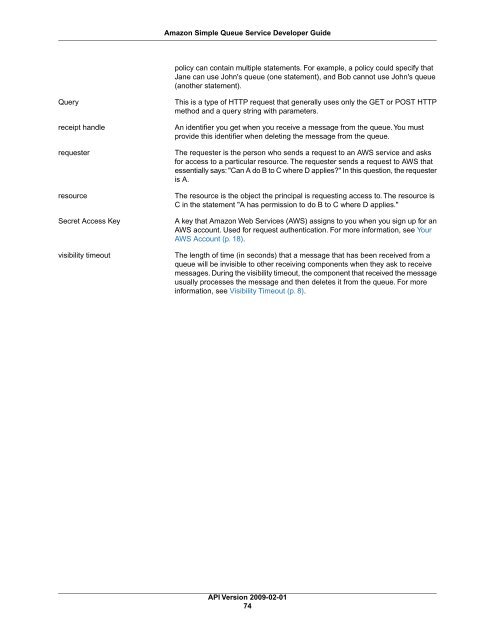You also want an ePaper? Increase the reach of your titles
YUMPU automatically turns print PDFs into web optimized ePapers that Google loves.
Amazon Simple Queue Service Developer Guide<br />
policy can contain multiple statements. For example, a policy could specify that<br />
Jane can use John's queue (one statement), and Bob cannot use John's queue<br />
(another statement).<br />
Query<br />
receipt handle<br />
requester<br />
resource<br />
Secret Access Key<br />
visibility timeout<br />
This is a type of HTTP request that generally uses only the GET or POST HTTP<br />
method and a query string with parameters.<br />
An identifier you get when you receive a message from the queue. You must<br />
provide this identifier when deleting the message from the queue.<br />
The requester is the person who sends a request to an AWS service and asks<br />
for access to a particular resource. The requester sends a request to AWS that<br />
essentially says: "Can A do B to C where D applies?" In this question, the requester<br />
is A.<br />
The resource is the object the principal is requesting access to. The resource is<br />
C in the statement "A has permission to do B to C where D applies."<br />
A key that Amazon Web Services (AWS) assigns to you when you sign up for an<br />
AWS account. Used for request authentication. For more information, see Your<br />
AWS Account (p. 18).<br />
The length of time (in seconds) that a message that has been received from a<br />
queue will be invisible to other receiving components when they ask to receive<br />
messages. During the visibility timeout, the component that received the message<br />
usually processes the message and then deletes it from the queue. For more<br />
information, see Visibility Timeout (p. 8).<br />
API Version <strong>2009</strong>-<strong>02</strong>-<strong>01</strong><br />
74

















